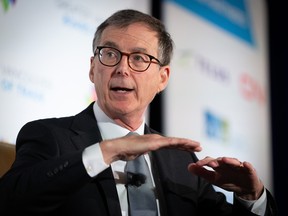Last week may mark a move away from strict inflation targeting by the world’s most influential central banks

Article content
By Mohamed El-Erian
It would not surprise me if future economic history books were to look back at the last week in central banking as marking a move away from strict inflation targeting by the world’s most influential central banks.
Article content
While far from being definite or risk free, it is a shift that would be consistent with superior economic outcomes and stands a reasonable chance of working. And it is a policy approach that is likely to be superior to others as central banks tackle an operating environment that is particularly fluid economically and politically at domestic and global levels.
Advertisement 2
Article content
It is not often that you see a reputable central bank revise up its inflation and growth projections and yet strengthen a dovish tilt to its policy stance. Yet that is what happened in Washington last week when the United States Federal Reserve raised those projections up a notch and yet delivered two consequential signals: a willingness to tolerate higher inflation for longer and an openness to slow the ongoing reduction in its balance sheet.
Article content
Reacting to these unexpected signals of monetary policy patience, markets pushed stocks and gold significantly higher to record levels. Moreover, bond prices rose as traders became more confident that the Fed might cut interest rates as early as June despite hotter-than-expected inflation reports for January and February.
Fed chair Jay Powell justified the central bank’s stance by saying the inflation story was “essentially the same” despite this data and the upward revision in its own inflation projections.
Fed not the only dove
But the Fed was not the only central bank that markets deemed surprisingly dovish. Two days before the Fed, the Bank of Japan wrapped its first interest rate increase in 17 years in dovish packaging. Despite the Bank of Japan also announcing an exit from its policy of capping bond yields, the yen weakened against the dollar rather than appreciated on the news that Japan was the last central bank to move nominal interest rates into positive territory.
Article content
Advertisement 3
Article content
Japan’s hotter-than-expected inflation made its “dovish hike” even more notable, pushing the currency close to a 32-year low. The dovish central bank surprises did not stop there. A day after the Fed meeting, the Swiss National Bank unexpectedly cut its interest rates, knocking about one per cent off the value of its currency.
Now, each of these moves could be explained by country-specific factors. Undoubtedly, and using a clever distinction I heard years ago from my former Pacific Investment Management Co. LLC colleague Andrew Balls, last week’s central bank outcomes were correlated rather than co-ordinated.
Paradigm shift
Having said that, they are consistent with a bigger macroeconomic paradigm shift that central banks will eventually be forced to embrace in an explicit fashion. Every week, we seem to get a new sign that the supply side of the global economy is working less flexibly than before and, crucially, than needed.
The causes range from economic rigidities and structural transitions to geopolitical shocks and the trumping of national security over economics in determining key cross-border investment, technology and trading relations. The result is a supply side that will not easily allow inflation to quickly fall back to two per cent and stay there without unnecessary damage to economic well-being and financial stability.
Advertisement 4
Article content
Do not get me wrong. We will not get big announcements of a change to inflation targets, not when central banks have missed their targets so much after mischaracterizing inflation as “transitory” three years ago.
Instead, it will be a slow progression, led by the Fed. Central banks will first push out expectations on the timing of the journey to two per cent and then, well down the road, transition to an inflation target based on a range, say two per cent to three per cent.
Some will view this as further undermining central bank credibility and threatening the de-anchoring of inflationary expectations. They will point to the horrible experience of the 1970s, when central bankers prematurely declared victory over inflation only to see it head back up, requiring the imposition of a big recession to bring it under durable control.
Recommended from Editorial
-

Investors should still expect a bumpy road ahead
-

Why passive investing makes less sense now
-

The mutual fund turns 100: is it becoming obsolete?
This possibility is a small risk and one that is justified in taking by the potential upside for overall economic wellbeing. It would be particularly impactful if accompanied by additional government measures to promote more flexible supply, including by focusing on greater labour force participation, better skill retooling, improved infrastructure and more public-private partnership to advance tomorrow’s engines of growth, particularly in generative artificial intelligence, life sciences and green energy.
Mohamed El-Erian is president of Queens’ College, Cambridge, and an adviser to Allianz and Gramercy
© 2024 The Financial Times Ltd.
Article content
This central bank shift could go down in history
2024-03-27 14:21:03







